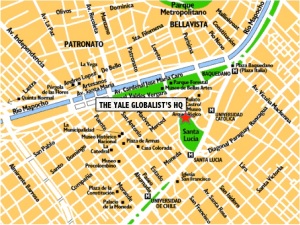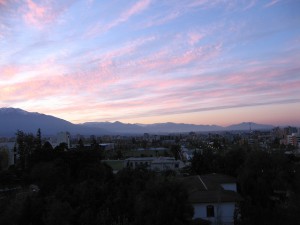by Cathy Huang
We have arrived!
Despite the close to eleven hour flight, two meals on-board, a nice selection of in-flight entertainment to satisfy those too restless or folded up in their seats to fall asleep, we’ve ended up in the same exact time zone. That’s right! Santiago is U.S. Standard EST time, so our grogginess can’t be attributed to jet lag after all–just to post-finals burnout, uncomfortable makeshift seat-beds, and, for me at least, a seemingly endless packing crusade that had me bouncing on my suitcase to get it closed but still haunted by the itching sensation that I’ve forgotten something in New Haven.
But there’s no looking back now! We’ve officially set up camp in Santiago, Chile’s capital city that has, as our native Chilean trip member Diego described it, “no sense of suburbia.” And at 248 square miles, boasting 6 million (a third!) of Chile’s entire population, Santiago is a South American metropolis, the hub of everything and our home for the next week. Curious as to where we are?
Our trip coordinators found us an ideal place to stay—at the northern tip of Santa Lucia park, whose cerro, or hill, promises a panoramic view of the city. Our climb will have to wait until later this week or until this weekend, though. Our Adean skyline to the East, inspired by images like the one you see at the top of this blog, is currently sleeping under a heavy sheet of fog. The obstructed view will hopefully make the view even more breathtaking these next few days; we’ve been assured that the sun rises from behind the mountains. But all we saw was an orange half-orb, reflecting off hypothetical snow peaks to paint the sky a pink-purple hue like nothing I’ve seen before.
Colors here remind us that we’re not in New Haven anymore. The leaves are changing. The Rio Mapocho, the Mapocho River, cuts the city in half, and its eroded banks form basin sediment striations in burgundy, grays, and spots of green where flora show their heads. I personally can’t wait to explore the natural enclaves in this urban playground. The Chileans seem to treasure their natural resources and delicate landscapes despite its rapid economic growth in the last few decades. Some of our writers are researching environmental issues and renewable energy in this country, and when I see the mountains whose snow hats might disappear with climate change, and the river whose water resembles a thick chocolate milk, the dangers of environmental degradation become more real, more urgent, more unacceptable.
But for now, we have plenty to discover in the way of urban design and construction. Santiago’s main square is the Plaza de Armas, the equivalent of a Central Park or the EL Zocalo in Mexico. When the Spanish Conquistadores designed the city, they followed a grid pattern, leaving the central block vacant to form the Plaza for royal ceremonies and marches. The name traces back to a protectionist desire: in case of an attack, Santiago would be supplied necessary arms from the city center.
Every nation has its hero. Here, the title goes to Bernardo O’Higgins, who helped free Chile from Spanish rule in 1823. His statue and face are ubiquitous. His famous command reads: “Lads! Live with honor, or die with glory! He who is brave, follow me”. Historical legacies are indelible in this country. Every article topic we come up with demands a consideration of its historical context—whether its how Pinochet’s dictatorship influenced evangelism, how Michelle Bachelet’s reign as the first female president has changed the face of Chilean sexism, or, more subtly, how Chile’s postcolonial formation has branded its people with a distinct national pride.
And also, apparently, a love for welcoming foreigners. Throughout the day, we received impromptu Spanish lessons from cab drivers. Well, before that happened, a smiling man on the street stopped Seth’s mindless arm flailing to instruct him on how to properly hail a cab (arm straight and low, below the waist). A businessman on the way to work offered to show me, in impeccable English, where to go to exchange our dollars into Chilean pesos.
We arranged meetings on our first day with young publications in Santiago. Half of our group met with the Editor in Chief of the Santiago Times, a leading English news source here, and the other half with Walker Rowe and George Allen at GringoLandiaSantiago, an English publication with a literary bent. We’re so grateful to these professional journalists for giving us a warm Buenos dias! welcome, an overview of the hot issues here, and tips on reporting with precision and tact.
George Allen, a recent US university graduate writing and teaching English here in Santiago, summed up our first impressions of this city and country with a well-placed reminder: “Chileans might be more timid than Americans. But once you gain their confidence, they’re effusive and kind. Approach them with a kind face. You won’t regret it.”
I can’t wait to share more of our adventures with you in the two weeks ahead. But for now, know that we’ve landed, moved in, and that we’re in good hands.

